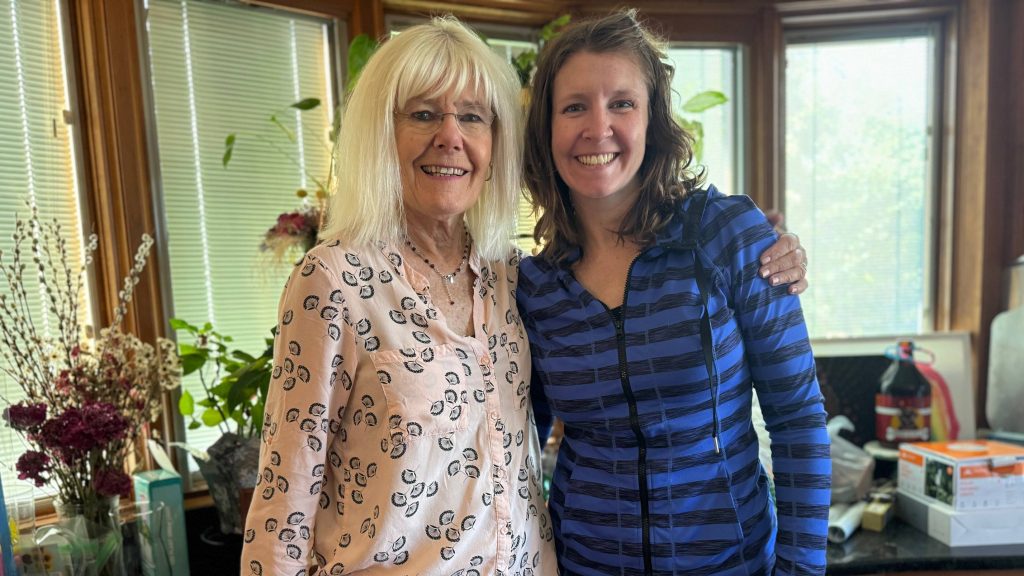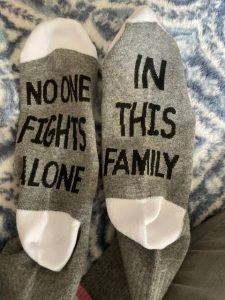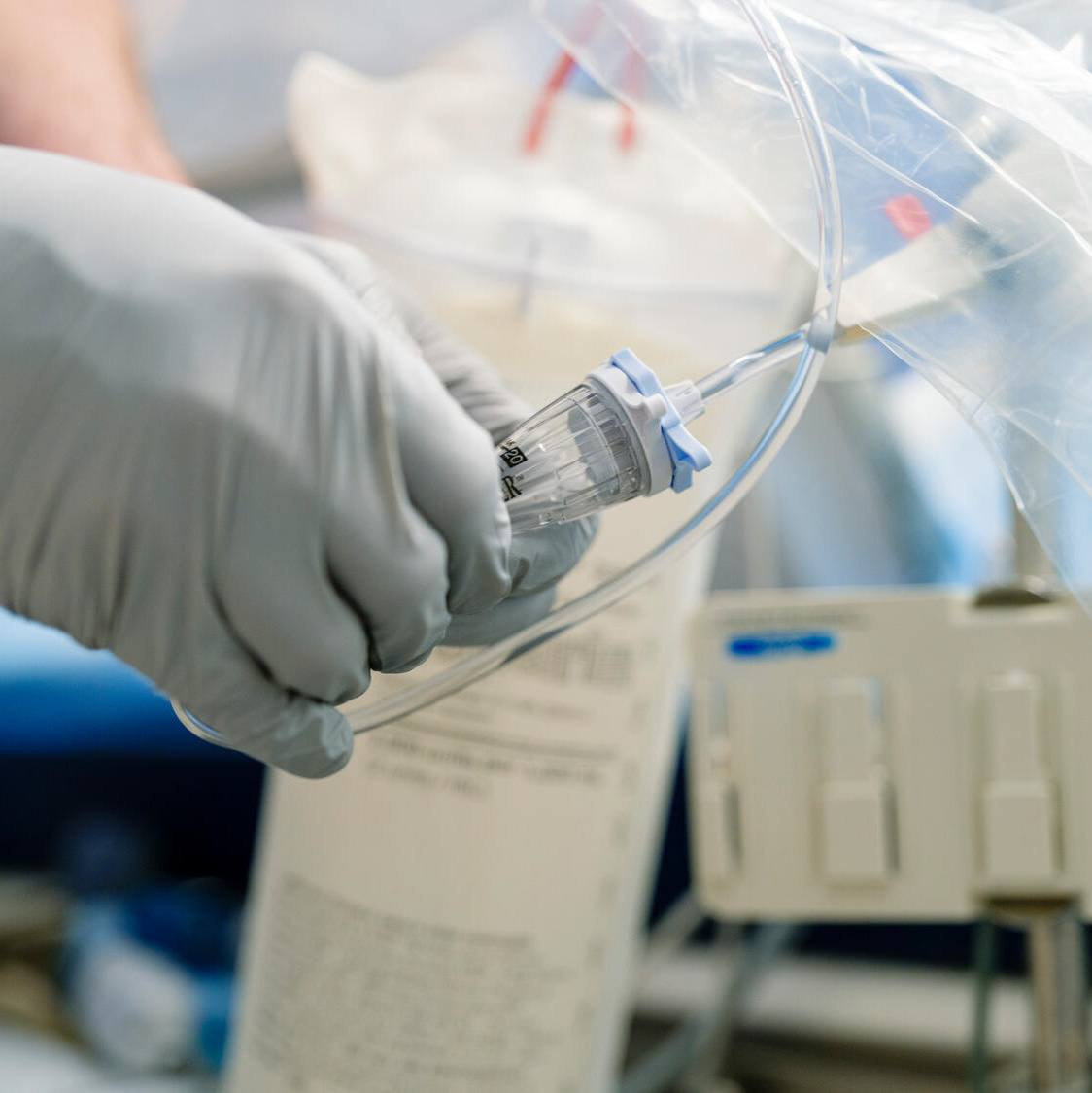-
A shared journey through breast cancer

When Samantha Duke discovered she had breast cancer, she didn’t have to look far for support. Her mother Jane walked a similar path 16 years earlier. Inspired both by her mom and the strong network of healthcare physicians and professionals on her team, Samantha remained positive throughout her treatment and is committed to advancing research on breast cancer.
Jane Hanson vividly recalls the day in late April 2022 when her 37-year-old daughter Samantha Duke learned that she had stage 3 breast cancer.
“I remember that terrible phone call,” Jane says. “We were both just in shock — we couldn’t believe it because she was diligent about having exams and getting tested.”
Samantha’s vigilance about self-exams and monitoring stemmed from watching her mother battle breast cancer. Just 16 years earlier, at age 56, Jane faced her own fight with the condition.
“I’ve always been hyper-aware of and tracked any changes in my breast health,” says Samantha, who is an associate project manager in Supply Chain Management at Mayo Clinic in Rochester, Minnesota. “I was in line to start preventative mammograms at age 40, but at 37 I found a lump.”
Samantha’s discovery of the lump in her left breast prompted a push for answers and a referral from her Mayo Clinic primary care physician to the Breast Clinic. Laboratory analysis of biopsied breast and lymph node tissue revealed Samantha had a high-grade adenocarcinoma. That diagnosis set Samantha on a fast-moving course through treatment and recovery walked by her mother and millions of women before her.
“If my mom and I were close before, we are now bound together on a whole other level,” Samantha says. “It's hard to explain actually, but it's a deep-seated connection that I will cherish going forward.”
Having a breast cancer survivor as one of her biggest cheerleaders provided Samantha with a positive, hope-filled perspective that colored her journey. Access to leading-edge diagnostic tools, which enabled swift characterization of her cancer, paved the way for tailored treatment that eliminated cancer cells in her body.
“In terms of testing early on, I really threw all of my trust in their plan,” Samantha says. “Mayo's approach to oncology care is beyond words. It's overwhelming how many groups are available for support and care 24 hours a day, seven days a week, 365 days a year.”
Her mom, who has been cancer-free for 16 years, couldn’t agree more. “You just feel like it’s a big family,” Jane says. “It's so important and I think makes the patient feel so much more comfortable knowing that everybody is talking to each other. I just cannot say enough about the teamwork.”
Clarity, confidence, customization
For Samantha, who lives with her husband, Scott, and 7-year-old daughter in Rochester, the speed at which a multidisciplinary team formed around her bolstered Samantha’s sense that her care was a priority.
“Before any of my treatment plans started, my surgical oncologist, radiation oncologist, and medical oncologist met in person to discuss my case, treatment plans, and moving forward,” Samatha says. “They all agreed on the path, making me feel so confident in what I was about to get into.”
The team’s decision-making process was informed by the results of Samantha’s laboratory testing. Because of Jane’s diagnosis, genetic testing was ordered to determine if Samantha had a hereditary cancer syndrome. Mayo Clinic Laboratories offers a full line of testing for hereditary cancer syndromes, including for breast and gynecological illness (Mayo ID: BRGYP).
“I wanted to make sure that if this was a genetic thing, I could best prepare my daughter and make sure she has an awareness,” Samantha says. Thankfully Samantha was negative for any genetic variants that could have been passed to her daughter.
Immunohistochemistry testing performed on the tumor (Mayo ID: HERMB) at Mayo Clinic, however, revealed certain traits, including HER2 positivity, that painted a clearer picture of the cancer.
Among women who have breast cancer, about 15% have HER2-positive breast cancer, says Samantha’s medical oncologist, Roberto Leon-Ferre, M.D.
“It's a small proportion of women with breast cancer, but until the late 1990s, this was considered one of the most aggressive and lethal subtypes of breast cancer,” Dr. Leon-Ferre says.
The high rates of mortality for HER2 patients compelled researchers to focus on finding an effective treatment, Dr. Leon-Ferre adds.
“Mayo Clinic investigators were heavily involved in the original clinical studies that led to the approval of the medications that we now use routinely, and in the refinement of testing for HER2,” Dr. Leon-Ferre says. “And now that we have several effective drugs that target the HER2 protein, this is now one of the most curable subtypes of breast cancer.”
Among the treatments developed to specifically target HER2-positive patients was one prescribed to Samantha. TCHP chemotherapy is a four-drug cocktail that targets HER2-positive breast cancer cells. Just one month after diagnosis, Samantha received the first in a yearlong journey of infusions.
“The nursing staff on Gonda 10 East are nothing short of spectacular,” Samantha says, explaining that they gave her daughter a chemo Barbie with multiple wigs and a shirt that read: Strong Like Mom.
“It does take a village to treat a single patient with breast cancer,” Dr. Leon-Ferre says. “When patients come into the Breast Clinic, multiple teams of breast cancer specialists gather in that same clinic to review each case in detail. Rather than the patient moving to each one of our offices, we come to the patient. In conjunction, we determine the best treatment strategy, and we all meet with the patient that same morning.
“The advantage of this approach is that it allows us to come together with a comprehensive plan, and on that same day the patient can leave with a clear direction of what the next steps will be,” Dr. Leon-Ferre says.
Inspiration, optimism, altruism
Throughout Samantha’s treatment, which also included surgery to remove the tumor and surrounding tissues and 25 sessions of proton beam radiation therapy, her husband and mother were a constant support.

“When my diagnosis came there were a lot of emotions — fear, anger, sadness,” Samantha says. “My husband, daughter, and both of my parents were with me from the very beginning. If my husband wasn't able to be with me at an appointment or for chemotherapy sessions, my mom would be there. It was this unspoken notion that I would never be alone through the journey.”
Jane’s journey with cancer, which was stage 1 and HER2-negative when discovered, involved a mastectomy and taking the chemotherapy pill tamoxifen for five years. Throughout her recovery, Samantha was a key support.
“After her surgery, my mom needed someone to be with her, so I quit my job and stayed home to offer support,” Samantha says.
In Jane’s own life, having a strong support network helped her manage the anxiety and exhaustion caused by the condition.

“It’s just wonderful to have family and friends to share with and talk about the journey together,” says Jane. “Samantha and I talked a lot about staying positive. But you do worry about your daughter growing up. So we talked about how Samantha would be here when her daughter graduates and we were thinking positive thoughts constantly. We were so lucky that we have each other and we can share this journey and the next.”
Putting a positive spin on and finding humor in her situation was essential to remain hopeful, Samantha says.
“Every day I looked for the positive and made fun of the situation,” Samantha says. “I don’t remember every activity, but I remember laughing a lot.”
The gratitude that’s grown out of her experience and outcome has motivated Samatha to use her experience to help others.
“I do not discount my privilege of not only working for Mayo, but for being a patient,” Samantha says. “This time in my life has taught me about what it is to be truly grateful for all I have. Every research study they offered, I signed up for. If small pieces of good can come from my experience, then this wasn’t for nothing.”
Witnessing Samantha boldly face her diagnosis, push for answers, and enroll in research has been inspiring, Jane says.
“I'm so proud of her. She wasn’t afraid to question everything and everyone,” Jane says.
While Samantha’s future is not certain — she receives follow-up testing every six months — her experience has shown her that her team is prepared to handle whatever comes her way.
“I may have no idea what tomorrow will bring, but knowing Mayo Clinic has my back allows me to focus on other aspects of this journey with renewed energy,” Samantha says.
This article first published on the Mayo Clinic Laboratories blog.







